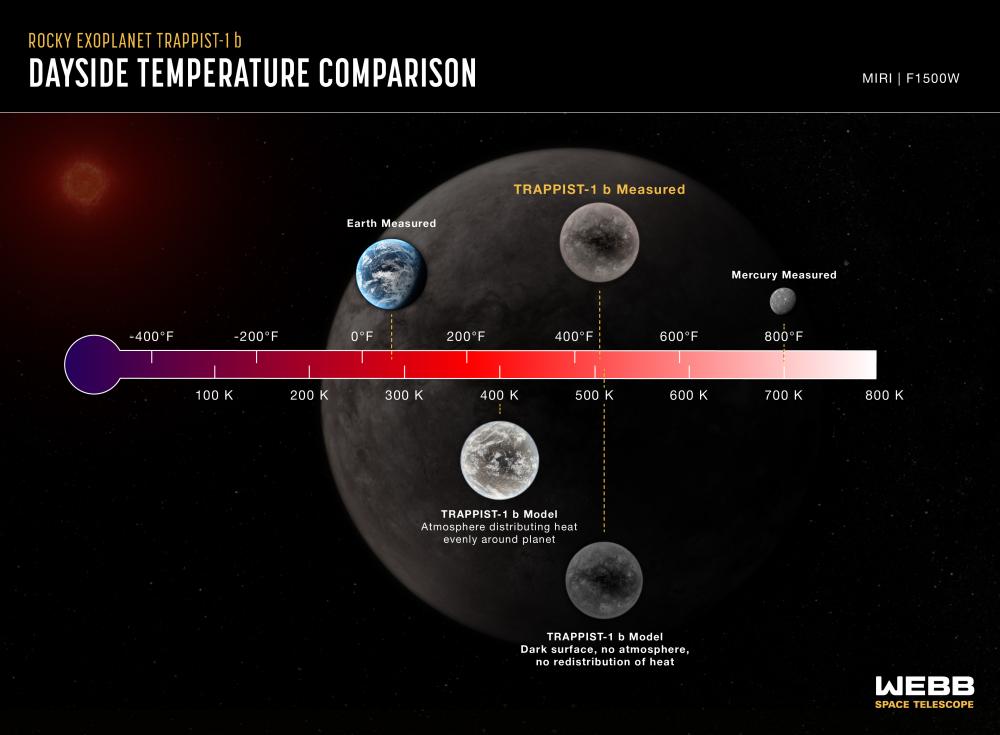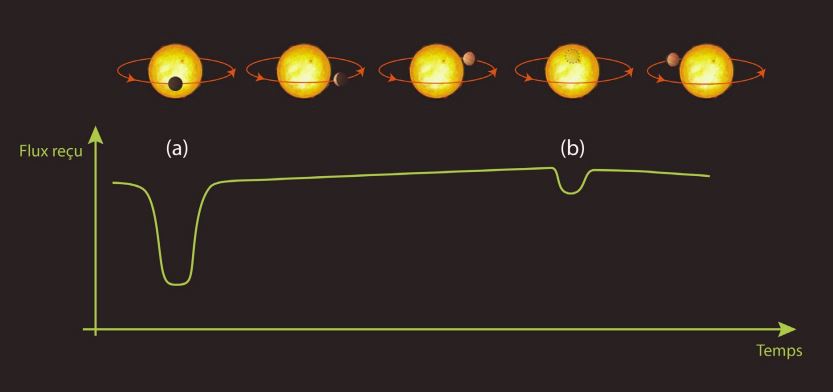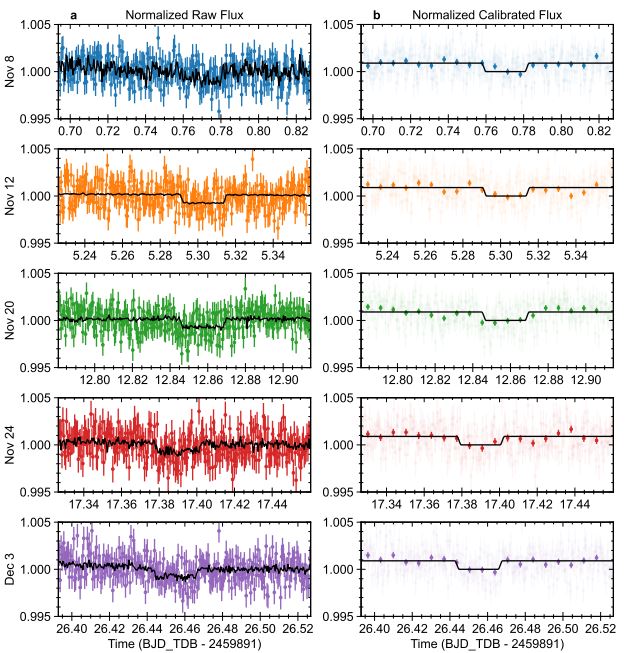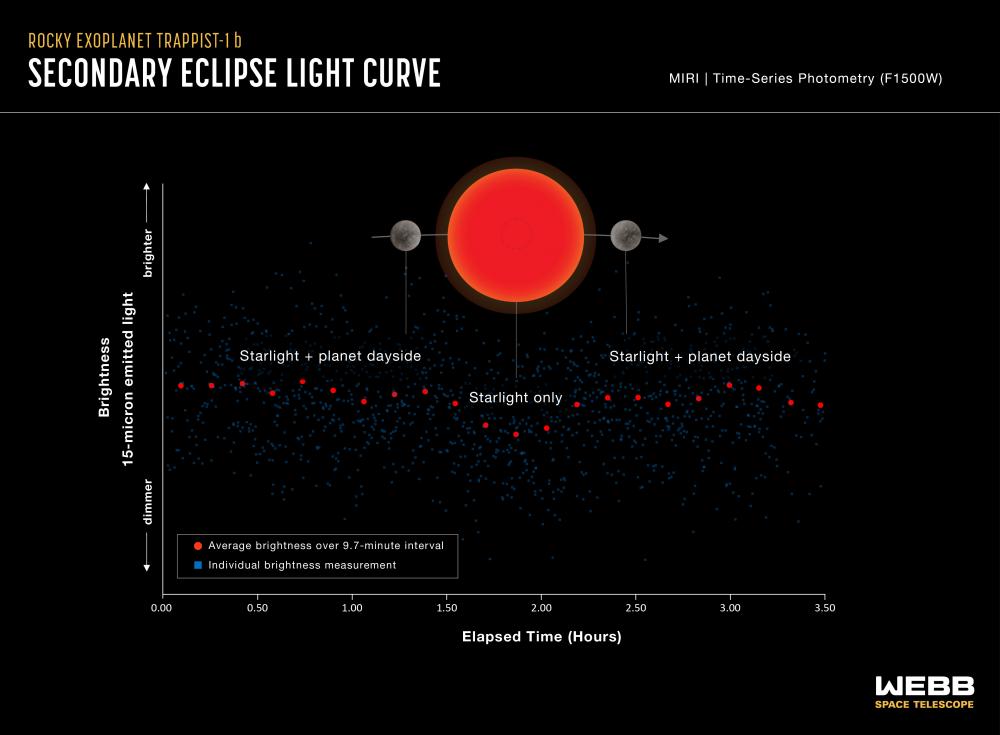
Comparison of the daytime temperature of TRAPPIST-1 b, measured by Webb's MIRI instrument, with models showing what the temperature would be under various conditions. The observational results show that the daytime brightness of TRAPPIST-1 b at 15 microns corresponds to a temperature of about 227 °C (500 K). ILLUSTRATION: NASA, ESA, CSA, Joseph Olmsted (STScI) ; SCIENCE: Thomas P. Greene (NASA Ames), Taylor Bell (BAERI), Elsa Ducrot (CEA), Achrène Dyrek (CEA), Pierre-Olivier Lagage (CEA)
An international team of researchers has used NASA's James Webb Space Telescope to measure the temperature of the rocky exoplanet TRAPPIST-1 b. This is the world's first detection of thermal emission from a rocky exoplanet as small and “cool” as the rocky planets in our own solar system. TRAPPIST-1 b receives about twice the amount of energy as Venus receives from the Sun and four times more than Earth. The result indicates that the dayside of the planet has a temperature of about 227°C (500 K) and suggests that it has no significant atmosphere. The study, co-authored by three researchers from the Dap, has just been published in the journal Nature, on Monday 27 March.
The TRAPPIST-1 planetary system, a laboratory for studying rocky Earth-like planets beyond the Solar System
The TRAPPIST-1 system is remarkable for its seven planets, which are similar in size, mass, density and stellar heating to the rocky planets Venus, Earth and Mars in our own Solar System. Their sizes range from 0.75 to 1.15 times the radius of Earth, and their orbital periods from just 1.5 to 19 days. All the planets in the TRAPPIST-1 system have been observed with the Hubble or Spitzer space telescopes. Hubble observations have shown that none of the seven planets have a hydrogen-rich atmosphere.
TRAPPIST-1 b, the innermost planet, has an orbital distance of about one hundredth that of the Earth and receives about four times the amount of energy that Earth receives from the Sun. Although it is not in the system's habitable zone, studying this planet can provide important information about the other six planets in its sibling system, as well as those in other dwarf star systems, such as the star TRAPPIST-1. While the exoplanet TRAPPIST-1 b is not hot enough to emit its own light in the visible range, it does emit light in the infrared.
MIRIm (MIRI’s imager) is the only imager on the Webb Telescope that observes in the mid-infrared, wavelengths particularly well suited to capturing the faint glow emitted by such planets and detecting components of their atmosphere or surface.

Schematic representation of a planetary transit. (a) is the primary transit, (b) is the secondary transit
The MIRIm imager, designed, integrated and characterised under the responsibility of the CEA, has detected its first secondary eclipses!
The team used a technique called secondary transit photometry, in which MIRIm measured the change in brightness of the system when the planet disappears behind the star.
By comparing the difference between the infrared light flux measured just before the secondary transit (star + planet system) and the flux received during the secondary transit (star alone), the astronomers deduce the light emitted by the day side of the planet facing the star. They can then calculate its average temperature.
The five secondary eclipses were observed using MIRI's F1500W filter, which only allows light with wavelengths between 13.5 and 16.6 micrometers to pass through to the detectors. These measurements correspond to 25 hours of observations.
The detection of a secondary eclipse by MIRIm is an important step in itself, as it involves measuring tiny changes in brightness.
Since the star is more than 1,000 times brighter than the planet, the variations in brightness are less than 0.1%.
Out of the five measured transits (November 8, November 12, November 20, November 24, and December 3, 2022), MIRIm was able to detect changes as small as 0.027%.
While MIRIm's performance was fully validated and published in July 2022, this is the first publication of a secondary transit observed by JWST! These imaging capabilities confirm its relevance for measuring the thermal emission of exoplanets in order to study their atmosphere and surface.

Light curves of individual observations and models.
Left column: The raw light curves of each of the five transits, normalised by their median value, are represented in colour, while the fitted model is shown as a black line.
Right column: The same data and model for each transit after the removal of systematic noise.
Figure taken from the article: https://www.nature.com/articles/s41586-023-05951-7

The graph shows the combined data from five separate observations.
The blue squares correspond to individual brightness measurements. The red circles represent measurements grouped into bins or averaged to facilitate the visualisation of the temporal evolution. The decrease in brightness during the secondary eclipse is less than 0.1%.
ILLUSTRATION: NASA, ESA, CSA, Joseph Olmsted (STScI). SCIENCE: Thomas P. Greene (NASA Ames), Taylor Bell (BAERI), Elsa Ducrot (CEA), Achrène Dyrek (CEA), Pierre-Olivier Lagage (CEA)
Why would TRAPPIST-1 b not have an atmosphere?
The observational results show that the brightness of the day side of TRAPPIST-1 b at 15 microns corresponds to a temperature of about 227°C (500 K). If the stellar irradiation energy were distributed evenly around the planet (for example, by a circulating atmosphere free of carbon dioxide), the temperature at 15 micrometres would be 127°C (400 K). If the atmosphere contained a significant amount of carbon dioxide, it would emit even less light at 15 micrometres and appear even colder.
"We compared the results with computer models showing what the temperature should be in different scenarios," explained Elsa Ducrot, an astrophysicist at DAp who has been studying the TRAPPIST-1 system for six years. "The results are almost perfectly consistent with a blackbody composed of bare rock with no atmosphere to circulate heat. We also did not observe any signs of light absorption by carbon dioxide, which would be evident in these measurements. However, this is a measurement at a single wavelength (15 micron filter (15-micrometer filter), and more observations will be needed to confirm this result.”
Although TRAPPIST-1 b is warm compared to Earth, it is cooler than the sunny side of Mercury, which consists of bare rock and no significant atmosphere. Mercury receives about 1.6 times more energy from the Sun than TRAPPIST-1 b does from its star.
Pierre-Olivier Lagage, who has worked on the development of the MIRI instrument for more than twenty years says:
"There was a target I dreamed of. This was it. This is the first time we can detect the emission from a rocky, temperate planet. This is a truly important milestone in the history of the study of exoplanets".
Further observations of TRAPPIST-1 b with other MIRIm filters and observations of another TRAPPIST-1 exoplanet are already underway to confirm (or not) these initial findings.
For Elsa Ducrot,
« In only 25 hours of observation with the JWST we were able to observe the secondary transit of TRAPPIST-1 b, whereas hundreds of hours with the Spitzer telescope were not enough! With the JWST we are finally entering the regime of temperate rocky planets, a new era for exoplanetology».
For Achrène Dyrek, a third-year Ph.D. student studying exoplanets atmospheres, the excitement is overwhelming:
"I loved working with the data, analysing it, and above all, understanding its full meaning. Just one year after its launch, JWST is already opening the doors to unexplored worlds. I am so eager to discover all the pioneering work it will allow us to accomplish in the years and even decades to come. I feel like I'm almost touching a rocky planet like Mercury or Venus but located nearly 40 light-years away from Earth. This is a invaluable opportunity!"
Contacts: Elsa Ducrot, Achrène Dyrek, Pierre-Olivier Lagage
En savoir plus:
• Structure and evolution of the Universe › Planets, star's formation and dynamics, interstellar medium
• Department of Astrophysics (DAp) // UMR AIM
• Laboratory Dynamics of Stars, Exoplanets and their Environment
• JWST




